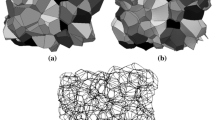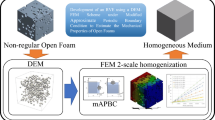Abstract
A 2D (two-dimensional) random cellular solid model was built using FEM (finite element method) based on a modified Voronoi tessellation technique. A sequence of permanent biaxial compression deformations was applied on the model to obtain a series of re-entrant random cellular solid structures with different area compression ratios. The Poisson’s ratio and energy absorption capacity of cellular solid models with different initial relative densities (0.032 and 0.039) were studied at different area compression ratios. The results showed that the Poisson’s ratio first decreased and then increased with increasing compression strain. A minimum Poisson’s ratio of approximately −0.38 was achieved with an appropriate compression strain. An empirical fitting rule was established which can best fit the 2D simulation to 3D experimental results for foams. The cellular solids with minimum negative Poisson’s ratio can exhibit the highest energy absorption capacity. Furthermore, mechanical properties of the random cellular solid model were compared with 2D regular honeycomb models with both concave- and convex-shaped cells. Results showed that the energy absorption capacity of the three models increased with an increasing dynamic compression velocity. The random foam model exhibited the highest increase rate in energy absorption capacity with the increasing compression velocity.







Similar content being viewed by others
References
Gibson LJ, Ashby MF (1988) Cellular solids: structure & properties. Pergamon Press, Oxford
Gibson LJ, Ashby MF, Schajer GS, Robertson CI (1982) The mechanics of two dimensional cellular solids. Proc R Soc Lond A382:25–42
Kolpakov AG (1985) On the determination of the averaged moduli of elastic gridworks. Prikl Mat Mekh 59:969–977
Karakoç Alp, Freund Jouni (2012) Experimental studies on mechanical properties of cellular structures using Nomex® honeycomb cores. Compos Struct 94:2017–2024
Karakoç Alp, Santaoja Kari, Freund Jouni (2013) Simulation experiments on the effective in-plane compliance of the honeycomb materials. Compos Struct 96:312–320
Wojciechowski KW (1987) Constant thermodynamic tension Monte Carlo studies of elastic properties of a two-dimensional systems of hard cyclic hexamers. Mol Phys 61:1247–1258
Grima JN, Alderson A, Evans KE (2005) Auxetic behaviour from rotating rigid units. Phys Status Solidi (b) 242:561–575
Milton G (1992) Composite materials with Poisson’s ratios close to −1. J Mech Phys Solids 40:1105–1137
Lakes RS (1987) Foam structures with a negative Poisson’s ratio. Science 235:1038–1040
Li Dong, Dong Liang, Lakes RS (2013) The properties of copper foams with negative Poisson’s ratio via resonant ultrasound spectroscopy. physica status solidi (b) 250(10):1983–1987
Friis EA, Lakes RS, Park JB (1988) Negative Poisson’s ratio polymeric and metallic foams. J Mater Sci 23:4406–4414. doi:10.1007/BF00551939
Lakes RS, Elms K (1993) Indentability of conventional and negative Poisson’s ratio foams. J Compos Mater 27:1193–1202
Timoshenko SP, Goodier JN (1969) Theory of elasticity. McGraw-Hill, New york
Zhu HX, Knott JF, Mills NJ (1997) Analysis of the elastic properties of open-cell foams with tetrakaidecahedral cells. J Mech Phys Solids 45:319–343
Choi JB, Lakes RS (1995) Nonlinear analysis of the Poisson’s ratio of negative Poisson’s ratio foams. J Compos Mater 29(1):113–128
Silva MJ, Gibson LJ (1997) The effects of non-periodic microstructure and defects on the compressive strength of two-dimensional cellular solids. Int J Mech Sci 39:549–563
Silva MJ, Hayes WC, Gibson LJ (1995) The effects of non-periodic microstructure on the elastic properties of two-dimensional cellular solids. Int J Mech Sci 11:1161–1177
Chen C, Lu TJ, Fleck NA (1999) Effect of imperfections on the yielding of two-dimensional foams. J Mech Phys Solids 47:2235–2272
Zhu HX, Hobdell JR, Windle AH (2000) Effects of cell irregularity on the elastic properties of open-cell foams. Acta Mater 48:4893–4900
Roberts AP, Garboczi EJ (2001) Elastic moduli of model random three-dimensional closed-cell cellular solids. Acta Mater 49:189–197
Zhu HX, Windle AH (2002) Effects of cell irregularity on the high strain compression of open-cell foams. Acta Mater 50:1041–1052
Kraynik AM, Reinelt DA, van Swol F (2004) Structure of random foam. Phys Rev Lett 93:208301-1–208301-4
Li K, Gao XL, Subhash G (2006) Effects of cell shape and strut cross-sectional area variations on the elastic properties of three-dimensional open-cell foams. J Mech Phys Solids 54:783–806
Bouakba M, Bezazi A, Scarpa F (2012) FE analysis of the in-plane mechanical properties of a novel Voronoi-type lattice with positive and negative Poisson’s ratio configurations. Int J Solids Struct 49:2450–2459
Papka SD, Kyriakides S (1999) In-plane biaxial crushing of honeycombs part II: analysis. Int J Solids Struct 36:4397–4423
Ashby MF, Evans AG, Fleck NA, Gibson LJ, Hutchinson JW, Wadley HNG (2000) Metal foams: a design guide. Butterworth Heinemann, Oxford
Rosakis P, Ruina A, Lakes RS (1993) Microbuckling instability in elastomeric cellular solids. J Mater Sci 28:4667–4672. doi:10.1007/BF00414256
Moore B, Jaglinski T, Stone DS, Lakes RS (2007) On the bulk modulus of open cell foams. Cell Polym 26:1–10
Scarpa F, Yates JR, Ciffo LG, Patsias S (2002) Dynamic crushing of auxetic open-cell polyurethane foam. Proc Inst Mech Eng Part C 216(12):1153–1156
Allen T, Shepherd J, Hewage TAM, Senior T, Foster L, Alderson A (2015) Low-kinetic energy impact response of auxetic and conventional open-cell polyurethane foams. phys status solidi (b) 252(7):1631–1639
Acknowledgements
This work was supported by “The National Natural Science Foundation of China (11304033) and the Fundamental Research Funds for the Central Universities (N150504006)”. The first author would also like to thank the financial support from the China Scholars Council (File No. 201506085013).
Author information
Authors and Affiliations
Corresponding author
Ethics declarations
Conflict of interest
The authors declare that they have no conflict of interest.
Rights and permissions
About this article
Cite this article
Li, D., Dong, L., Yin, J. et al. Negative Poisson’s ratio in 2D Voronoi cellular solids by biaxial compression: a numerical study. J Mater Sci 51, 7029–7037 (2016). https://doi.org/10.1007/s10853-016-9992-6
Received:
Accepted:
Published:
Issue Date:
DOI: https://doi.org/10.1007/s10853-016-9992-6




